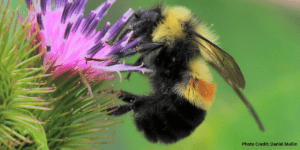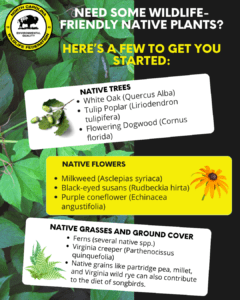Buzzing Back: The Rusty Patched Bumblebee and its Habitat

After the final frost of the winter, plant life begins to rally and insect life – including pollinators – begins to ramp up. This seasonal transition serves as a catalyst for numerous ecological processes, both seen and unseen.
As the soil begins to warm up, life begins to stir just beneath the surface. With twitching leg movements and a gentle flutter of wings, it begins its ascent – breaking through to the surface, greeted by the early light of spring.
Though this is not its first day of life, it is the first of the season after emerging from diapause, its version of hibernation. It emerges alone, having lost all of its colony at the beginning of winter. But this particular individual is unique, set apart from its peers.
It is, after all, her first day as queen.
The natural decline in bumblebees each year serves as a mechanism for resource conservation within the hive. However, this trend exacerbates the risk of overwintering mortality among bumblebee populations, particularly due to urban development and land degradation that endangers their underground nesting practices. These factors pose significant threats to all bumblebee species, particularly those classified as threatened or endangered, such as the rusty patched bumblebee.
March for Pollinators
In March, 2024, NCWF ushered in the colorful spring season by honoring March for Pollinators.
While the monarch butterfly has garnered the spotlight over the years for its vital pollinating role, stunning beauty, and precarious plight, it does not work alone in its pollinating prowess. A diverse array of pollinators are absolutely essential to the prosperity of plant life across our state.
Unfortunately, many of these pollinators face mounting pressures and declining populations due to habitat loss, urbanization, pollution, invasive plants, disease and detrimental agricultural and landscaping practices.
The state’s Wildlife Action Plan, crafted by the North Carolina Wildlife Resources Commission (NCWRC) and partners, identifies numerous pollinator species in need of conservation efforts. These species offer an invaluable pollinating service to a wide range of native plant species throughout the state, including those that mitigate erosion, provide shelter for wildlife, secure our food supply, moderate climate, and more.
The Rusty Patched Bumblebee
 Identified by a rust-colored patch on their abdomen, rusty patched bumblebees can be challenging to spot despite this distinctive feature. The rusty patched bumblebee (Bombus affinis) is native to the midwestern and eastern United States, as well as in some areas of Canada. Despite its expansive range, the species has suffered an 87% decline, leading to its federal listing as endangered in 2017, under the
Identified by a rust-colored patch on their abdomen, rusty patched bumblebees can be challenging to spot despite this distinctive feature. The rusty patched bumblebee (Bombus affinis) is native to the midwestern and eastern United States, as well as in some areas of Canada. Despite its expansive range, the species has suffered an 87% decline, leading to its federal listing as endangered in 2017, under the
Endangered Species Act.
Like many other bumblebee species, rusty patched bumblebees nest underground or on the surface in clumps of native grass or humus with wild nests containing up to approximately 1,000 members.
A shared trait among all bumblebees, the rusty patched employs buzz pollination, a technique involving the bee vibrating its flight muscles against the flower’s anther to dislodge adhered pollen molecules. This makes them vital pollinators for a variety of native plants and some crops that are important food sources for humans. However, their survival hinges on the quality and proximity of habitat for foraging, nesting, and hibernation habitats, a challenge contributing to their endangerment.
Numerous factors have brought about the rusty patched bumblebee’s precarious status, including pollution, pesticide use, invasive plant species, habitat loss, and disease. Nosema bombi, a parasitic fungus, threatens these and other bee species. Additionally, pests like hive beetles infiltrate bumblebee colonies, decimating food resources within the hive.
What Does NCWF Do For The Rusty Patched Bumblebees
The expansive habitat range, limited colony numbers, and underground nesting habits of rusty patched bumblebees pose challenges to effectively safeguarding their populations and habitats. While protection of specific, regional habitats benefit some endangered species (e.g., preserving longleaf pine forests for red-cockaded woodpeckers), rusty patched bumblebees lack specific regional habitat preferences, making it difficult to pinpoint their nesting sites.
 Consequently, comprehensive and broad-scoped strategies for policy and habitat restoration are necessary to support the survival of this species—a task that NCWF is uniquely positioned to embrace.
Consequently, comprehensive and broad-scoped strategies for policy and habitat restoration are necessary to support the survival of this species—a task that NCWF is uniquely positioned to embrace.
NCWF advocates for crucial species restoration policies like Recovering America’s Wildlife Act (RAWA) which, if passed by Congress, will aid species such as the rusty patched bumblebee.
Programs like The Butterfly Highway and Garden for Wildlife encourage landowners to provide essential habitat features for various pollinators and other wildlife species. These features include food, water, cover, and places to raise young. Establishing an interconnected web of wildlife habitats across the state directly addresses habitat loss and degradation, and is a way to provide food, nesting, and hibernating resources to pollinators, including native bees.
Additionally, through our statewide Community Wildlife Chapter network, NCWF facilitates hundreds of habitat restoration projects a year, including trash cleanups, invasive species removals, native tree and shrub plantings, and the creation of pollinator gardens.
Since the beginning of 2024 alone, NCWF Community Wildlife Chapters have facilitated:
- Five invasive species removals in Orange, Wake, Mecklenburg, Union, and Brunswick counties
- Five native plantings (including pollinator garden projects) in Iredell, Mecklenburg, Washington, Forsyth, and Orange counties
- Six trash cleanups in Camden, Bertie, Gates, New Hanover, Brunswick, and Mecklenburg counties
Habitat improvement projects go a long way towards providing native bees and other wildlife species with quality habitat for wildlife to survive and thrive. There are also steps that you can take at home in your own yard to support pollinators.
What More Can Be Done for Native Pollinators?
Addressing the challenges facing many native pollinator species presents a formidable endeavor, especially given some of the significant population declines in recent years. Nonetheless, various measures are being implemented to mitigate these threats, alongside actions individuals can take to facilitate their recovery.
Habitat
Many pollinators proximate foraging, nesting, and hibernating habitats, a challenging feat amidst ever-changing landscapes. It is imperative to provide these habitat components for native pollinators.
-
Preservation of Undisturbed Ground Cover:
Some bumblebee colonies seek refuge underground, with queens overwintering just below the surface, often within decaying wood and humus. Landowners are advised to refrain from excessive mulching or lawn cutting during critical periods of insect and pollinator hibernation. Disturbing insects and wildlife during hibernation, brumation, or diapause can lead to their harm or death.
-
Revitalization of Grasslands:
While many bumblebee species nest and overwinter in soil, they also inhabit clusters of organic matter, such as native grasses. The decline in native pollinators – and other wildlife species – is partly attributed to the loss of native grasslands. By restoring these habitats, nesting and overwintering sanctuaries can be restored for these species.
Food
 Many bumblebees forage from and pollinate various plant species. However, invasive species introduction and habitat loss have impacted food availability and nutritional density.
Many bumblebees forage from and pollinate various plant species. However, invasive species introduction and habitat loss have impacted food availability and nutritional density.
-
Native Plant Cultivation:
Planting native plants benefits all wildlife species. Native plants attract insects, including vital pollinators, while also providing nourishment for seed-eating birds and small mammals. Having evolved alongside the wildlife species that share their ecosystems, native plants contain the essential nutritional properties that these species require.
-
Provision of Watering Sites:
A simple bird bath or a small, chemical-free fountain serve as great hydration spots for wildlife – including pollinators. These can range from compact backyard features to meandering stream installations. It is important to ensure that there is vital plant cover along the edges of these water features to provide safety for wildlife coming to the water source.
-
Combating Invasive Plants:
Invasive plant species pose significant threats to native plants and wildlife by displacing the food sources that these wildlife species have come to depend upon. Identifying and removing invasive species early can prevent their establishment and aggressive spread. Upon removal of invasive species, replanting an area with native species helps prevent further invasion.
Practice Chemical-Free Landscaping
One of the significant concerns for pollinators is chemical contamination resulting from the application of detrimental insecticides, fungicides, herbicides, and fertilizers. While much of this chemical impact is perpetrated by large-scale farming operations, it’s nevertheless crucial to exercise caution regarding the chemicals employed in your own yard.
-
Natural Fertilizing and Pesticide Methods:
The utilization of chemicals in natural settings is often aimed at addressing pest issues and promoting agricultural productivity. However, these chemicals may yield more adverse consequences than benefits. When contemplating chemical application, do your research into alternative natural methods. For instance, rather than resorting to Roundup (which contains the pollinator-killing chemical glyphosate), consider using sheets of cardboard or tarps to naturally suppress weed growth. Similarly, opt for compost, manure, and other natural substances instead of chemical fertilizers to increase plant growth.
Join A Community Wildlife Chapter
Become a key part of the grassroots conservation effort to restore habitat, spread awareness, and rally around wildlife in North Carolina by joining a Community Wildlife Chapter.
North Carolina Wildlife Federation chapters are community-based organizations that together form a cohesive, statewide network of wildlife enthusiasts working for wildlife and habitat conservation.
Each Community Wildlife Chapter is uniquely designed to empower local wildlife supporters – including anglers, backpackers, birders, hunters, gardeners and hikers – to have a direct and effective impact on the conservation of wildlife in their local communities and across the state. Chapters host educational programs, conduct nature outings and restore habitat in their communities. You don’t have to be an expert to get involved in a chapter. All are welcome.
Find a Community Wildlife Chapter near you.
Donate
Donating to NCWF ensures that our ongoing work to protect, conserve, and restore pollinators can continue. Your donation will go towards restoring wildlife/pollinator habitats and food sources across the state, advocating for the continued protection of pollinators and other wildlife species listed under the Endangered Species Act, and educating people about efforts they can employ to ensure their continued presence in North Carolina.
Are you passionate about pollinators and concerned about their future here with us? Consider registering your yard as a Pollinator Pitstop on NCWF’s Butterfly Highway.
Want more content like this? We’ve got you covered…
Written by:

– Bates Whitaker, NCWF Communications & Marketing Manager

– Dr. Liz Rutledge, NCWF Director of Wildlife Resources


